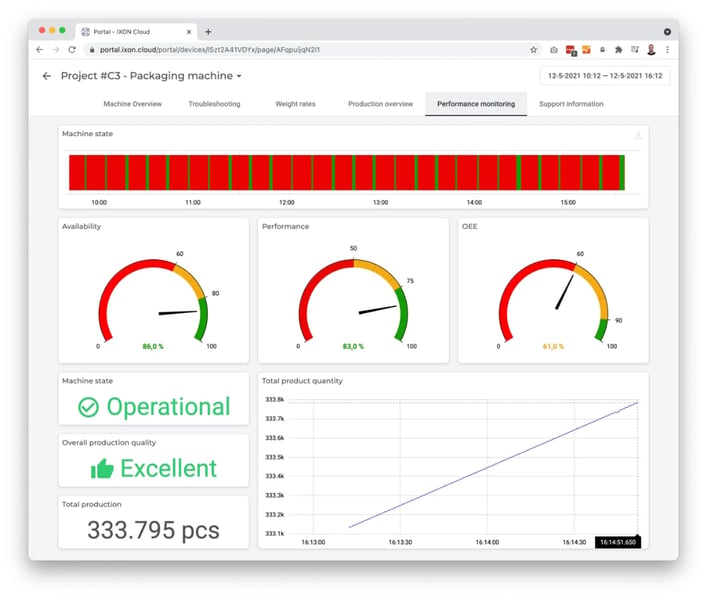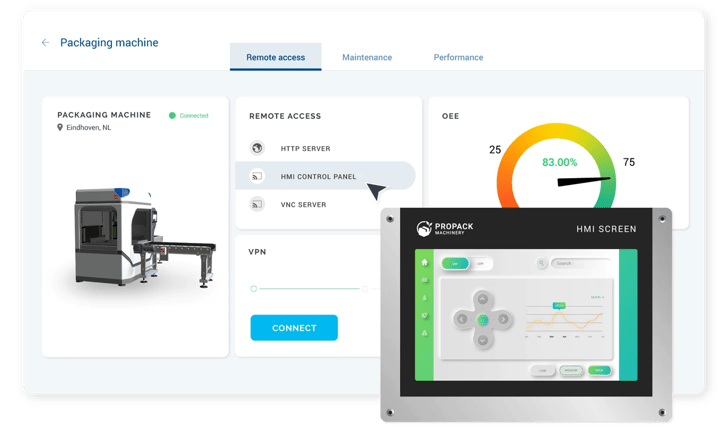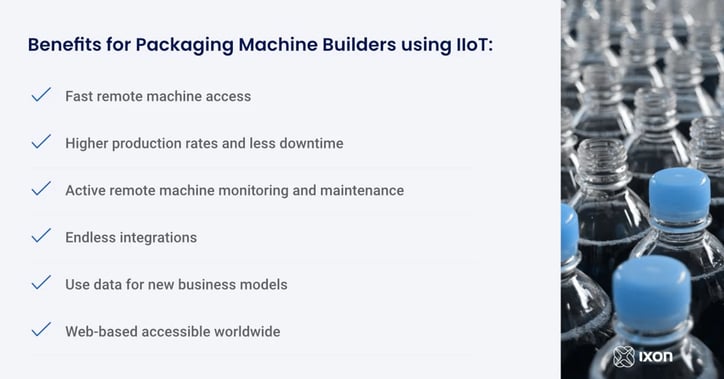- Home
- Knowledge hub
IoT as a Game Changer for machine builders in the packaging industry
5 min. read
Shelly Boom
As a packaging machine OEM, there is a good chance that you have already implemented elements of IoT. Often, we see IoT technology being implemented because the opportunity is there (or because it is expected), rather than to solve a real challenge for the business. In many cases, machine builders have not created enough added value. You might wonder how IIoT can create short and long term added value as a machine builder in the packaging industry.
How can IIoT connectivity and cloud be applied in the packaging industry? And how can machine builders implement IIoT and use data to evolve their business strategy? In this article, you'll learn what IIoT can do for you as a machine builder.
 IIoT for machine builders in the packaging industry
IIoT for machine builders in the packaging industryIIoT (known as the Industrial Internet of Things for manufacturing) is particularly applicable in the packaging industry. Connecting industrial packaging machines to the cloud - and sharing real-time data - can drastically affect the efficiency and development of machines and production, and reduce unplanned downtime.
The potential of IIoT technologies in the packaging industry is enormous. Some of the features that are possible with a scalable IIoT platform are:
On the manufacturing/packaging process side, IIoT helps to share machine information and improve overall efficiency. Customers are increasingly willing to give access to their machines and data in order to achieve higher productivity, provided all safety measures are ensured.
For machine builders, IIoT offers more opportunities to increase customer loyalty, improve service and introduce next generation machines. In addition, insights from machine data can also be used for new service models, creating new revenue streams or maximising productivity by reducing downtime throughout the machine lifecycle.
IoT connectivity and data from different types of industrial packaging machines are the basis for improvement. Starting with data logging is a necessity.
Research shows that wear and tear, human error and product changeover are the biggest contributors to packaging machine downtime. Take for example Sleeve Technology's machines that print cosmetics and food products at multinationals like Unilever and Campina. A breakdown in such production lines has major consequences. 'Downtime is undesirable. There can be perishable material in the tank,' says Coen van der Kant, Software Engineer at Sleeve Technology.
By monitoring data parameters, failures can be solved preventively, for example by adjusting configurations in case of alignment problems or imbalance, and maintenance can be performed in case of damage to bearings or other rotating parts.
Data from packaging machines help machine builders monitor machines and provide insights that can be converted into value. We’ve described some examples below.
Almost every packaging machine contains critical components that keep the machine running. Through sensors and real-time monitoring, standard values and deviations are measured. Operating hours, rotations, speed, noise, temperature, vibrations and energy consumption are examples of indicators that influence deviating behaviour.
By logging data in an IIoT platform, you can make benchmarks as well as proactive analyses to prevent machine downtime. The data leads to new insights and trends for the OEM and offers new business opportunities with conditional or predictive maintenance. A vibration analysis, for example, provides insight into common faults, such as imbalance, misalignment and loose machine parts.
Condition-based maintenance relies exclusively on real-time sensor measurements. When a parameter reaches an unacceptable level, maintenance engineers are sent out.
Predictive maintenance, on the other hand, relies on precise formulas in addition to sensor readings. Maintenance work is carried out before a failure can occur, which is determined from the analysis of these parameters.
 Example of performance monitoring dashboard of packaging machine
Example of performance monitoring dashboard of packaging machine
Waiting times caused by operator error or downtime can run high every year. The different machines in the packaging process can have an impact on this. Delays can occur in each process step - from the supply of packaging material, filling and weighing up to sorting, labelling and stacking. By structurally logging data from the individual process steps, the bottlenecks of the waiting times can be analysed.
To set up a more efficient flow process with maximum productivity, you can use data to analyse:
Machine learning methods and analysis of this data, complemented by the domain knowledge of the machine builder, can be used to improve machines and processes. Examples include the application of robot automation or the creation of learning programmes for operators to improve the use of the machine.
The exchange of machine data via the IIoT platform ensures close collaboration between operator and machine builder. This leads to more efficient operations, higher production rates and less downtime.
 Remote monitoring and control of a packaging machine via an IIoT platform
Remote monitoring and control of a packaging machine via an IIoT platform
The role of an IIoT platform for the machine builder is becoming increasingly central. These cloud-based portals provide additional service options and (start to) monitor real time machine information in clear dashboards.
The adoption of such platforms for remote monitoring and access has accelerated. Previously, OEMs might have scaled back their capabilities to keep machine prices competitive. Now, installations are often equipped with IoT connectivity as standard because of scalability and because PLC and HMI access is indispensable for remote diagnosis and fast troubleshooting.
A flexible IIoT platform such as IXON Cloud is able to combine the expertise of the machine builder's domain specialists with the data from the machines and provides answers to questions such as:
 7 Benefits for packaging machine builders using IIoT
7 Benefits for packaging machine builders using IIoTHow can IIoT play a relevant role for the packaging machine builder in the long and short term?
For many machine builders, it helps to start small and build up step by step. An IIoT project does not have to be a multi-million dollar upgrade. It could be, for example, adding one or more sensors that communicate with the PLC controller or a gateway device. This allows a company, in addition to remote access to the machine, to log initial machine data to build up historical data for the long term.
In the short term it is also possible to create useful dashboards with machine data to check performance, monitor machine components or create benchmarks and analysis for optimisations. All this is possible without large investments.
To help OEMs in their quest for a successful application of IIoT within their operations, we have compiled a white paper describing the route and steps from remote access to 'smart machines'. In this 20-page white paper you will find concrete tips and practical examples.
 If you would like to discuss your challenges with an expert, we would be happy to help you on your way. Please contact us for an obligation-free discussion about the possibilities of IIoT for your company.
If you would like to discuss your challenges with an expert, we would be happy to help you on your way. Please contact us for an obligation-free discussion about the possibilities of IIoT for your company.
Receive industry news, the latest updates on IXON products and their new features directly in your inbox with our monthly newsletter, and stay on top of market trends and information.